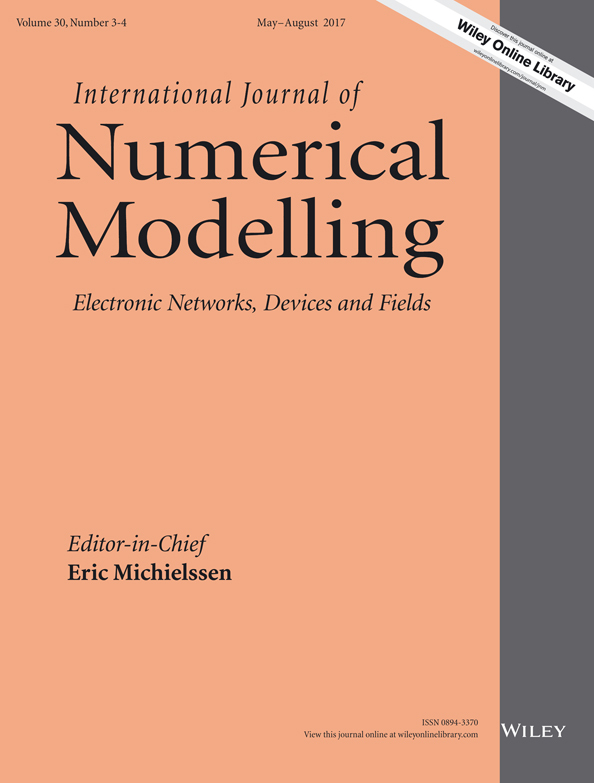A flexible memristive model with simplex basis function
Corresponding Author
Juntang Yu
Department of Automation, Tsinghua National Laboratory for Information Science and Technology (TNList), Tsinghua University, Beijing, 100084 China
Correspondence to: Juntang Yu, Department of Automation, Tsinghua National Laboratory for Information Science and Technology (TNList), Tsinghua University, Beijing 100084, China.
E-mail: [email protected]
Search for more papers by this authorXiangming Xi
Department of Automation, Tsinghua National Laboratory for Information Science and Technology (TNList), Tsinghua University, Beijing, 100084 China
Search for more papers by this authorShuning Wang
Department of Automation, Tsinghua National Laboratory for Information Science and Technology (TNList), Tsinghua University, Beijing, 100084 China
Search for more papers by this authorCorresponding Author
Juntang Yu
Department of Automation, Tsinghua National Laboratory for Information Science and Technology (TNList), Tsinghua University, Beijing, 100084 China
Correspondence to: Juntang Yu, Department of Automation, Tsinghua National Laboratory for Information Science and Technology (TNList), Tsinghua University, Beijing 100084, China.
E-mail: [email protected]
Search for more papers by this authorXiangming Xi
Department of Automation, Tsinghua National Laboratory for Information Science and Technology (TNList), Tsinghua University, Beijing, 100084 China
Search for more papers by this authorShuning Wang
Department of Automation, Tsinghua National Laboratory for Information Science and Technology (TNList), Tsinghua University, Beijing, 100084 China
Search for more papers by this authorSummary
In this paper, we propose a flexible memristive model with simplex basis function. In the memristive model, a piecewise window function is applied to limit the physical range of the state variable, and a piecewise linear model (called simplex basis function model) is applied to describe the integral function of the current and charge. The expression of the state variable and the memristance can be almost analytically obtained. Thus, some serious errors occurring in the simulations of some existing memristive models can be avoided. The proposed memristive model shows great flexibility due to the good approximation capability of the simplex basis function model. Copyright © 2016 John Wiley & Sons, Ltd.
References
- 1Chua L. Memristor-the missing circuit element. IEEE Transactions on Circuit Theory 1971; 18(5): 507–519.
- 2Chua L, Kang S. Memristive devices and systems. Proceedings of the IEEE 1976; 64(2): 209–223.
- 3Ventra M, Pershin Y, Chua L. Circuit elements with memory: memristors, memcapacitors, and meminductors. Proceedings of the IEEE 2009; 97(10): 1717–1724.
- 4Strukov DB, Snider GS, Stewart DR, Williams RS. The missing memristor found. Nature 2008; 453(7191): 80–83.
- 5Jo SH, Kim K-H, Lu W. High-density crossbar arrays based on a si memristive system. Nano Letters 2009; 9(2): 870–874.
- 6Ho Y, Huang GM, Li P. Dynamical properties and design analysis for nonvolatile memristor memories. IEEE Transactions on Circuits and Systems I: Regular Papers 2011; 58(4): 724–736.
- 7Ebong IE, Mazumder P. Self-controlled writing and erasing in a memristor crossbar memory. IEEE Transactions on Nanotechnology 2011; 10(6): 1454–1463.
- 8Jo SH, Chang T, Ebong I, Bhadviya BB, Mazumder P, Lu W. Nanoscale memristor device as synapse in neuromorphic systems. Nano Letters 2010; 10(4): 1297–1301.
- 9Kim H, Sah MP, Yang C, Roska T, Chua LO. Neural synaptic weighting with a pulse-based memristor circuit. IEEE Transactions on Circuits and Systems I: Regular Papers 2012; 59(1): 148–158.
- 10Thomas A. Memristor-based neural networks. Journal of Physics D: Applied Physics 2013; 46(9): 093001/1–093001/12.
- 11Itoh M, Chua LO. Memristor oscillators. International Journal of Bifurcation and Chaos 2008; 18(11): 3183–3206.
- 12Borghetti J, Snider GS, Kuekes PJ, Yang JJ, Stewart DR, Williams RS. Memristive switches enable stateful logic operations via material implication. Nature 2010; 464(7290): 873–876.
- 13Joglekar YN, Wolf SJ. The elusive memristor: properties of basic electrical circuits. European Journal of Physics 2009; 30(4): 661–675.
- 14Biolek Z, Biolek D, Biolková V. Spice model of memristor with nonlinear dopant drift. Radioengineering 2009; 18(2): 210–214.
- 15Prodromakis T, Peh BP, Papavassiliou C, Toumazou C. A versatile memristor model with nonlinear dopant kinetics. IEEE Transactions on Electron Devices 2011; 58(9): 3099–3105.
- 16Yu J, Mu X, Xi X, Wang S. A memristor model with piecewise window function. Radioengineering 2013; 22(4): 969–974.
- 17Mu X, Yu J, Wang S. Modeling the memristor with piecewise linear function. International Journal of Numerical Modelling: Electronic Networks, Devices and Fields 2015; 28(1): 96–106.
- 18Yang JJ, Pickett MD, Li X, Ohlberg DA, Stewart DR, Williams RS. Memristive switching mechanism for metal/oxide/metal nanodevices. Nature nanotechnology 2008; 3(7): 429–433.
- 19Pickett MD, Strukov DB, Borghetti JL, Yang JJ, Snider GS, Stewart DR, Williams RS. Switching dynamics in titanium dioxide memristive devices. Journal of Applied Physics 2009; 106(7): 1–6.
- 20Kvatinsky S, Friedman EG, Kolodny A, Weiser UC. Team: threshold adaptive memristor model. IEEE Transactions on Circuits and Systems I: Regular Papers 2013; 60(1): 211–221.
- 21Biolek D, Biolek Z, Biolkova V, Kolka Z. Modeling of tio2 memristor: from analytic to numerical analyses. Semiconductor Science and Technology 2014; 29(12): 125008.
- 22Ascoli A, Corinto F, Senger V, Tetzlaff R. Memristor model comparison. IEEE Circuits and Systems Magazine 2013; 13(2): 89–105.
- 23Strachan JP, Torrezan AC, Miao F, Pickett MD, Yang JJ, Yi W. Medeiros-Ribeiro G, Williams RS. State dynamics and modeling of tantalum oxide memristors. IEEE Transactions on Electron Devices 2013; 60(7): 2194–2202.
- 24Chen L, Li C, Huang T, Ahmad HG, Chen Y. A phenomenological memristor model for short-term/long-term memory. Physics Letters A 2014; 378(40): 2924–2930.
- 25Breiman L. Hinging hyperplanes for regression, classification, and function approximation. IEEE Transactions on Information Theory 1993; 39(3): 999–1013.
- 26Wang S, Sun X. Generalization of hinging hyperplanes. IEEE Transactions on Information Theory 2005; 51(12): 4425–4431.
- 27Xu J, Huang X, Wang S. Adaptive hinging hyperplanes and its applications in dynamic system identification. Automatica 2009; 45(10): 2325–2332.
- 28Chua LO. The fourth element. Proceedings of the IEEE 2012; 100(6): 1920–1927.




